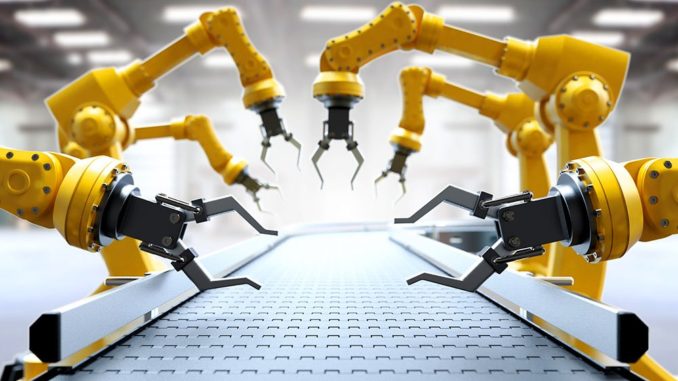
Industrial Automation Robotics Market Is ‘In Full Swing’ Post-Covid By Investors Business Daily
As the economy emerges from the Covid-19 pandemic, manufacturers are investing in more automation technologies to improve their productivity and efficiency. And the trend is positive for robotics stocks like ABB (ABB) and Teradyne (TER).
In the first quarter, sales of industrial robots in North America jumped 20% year over year to 9,098 units, valued at $466 million, according to the trade group Association for Advancing Automation, or A3.
Nonautomotive companies fueled the increase, A3 said. Industries seeing the biggest growth in robotics sales included metals, which soared by 86%. Next was life sciences, pharmaceutical and biomed, surging 72%. And food and consumer goods jumped 32%, according to A3.
Last year, orders of robots by nonautomotive sectors surpassed automotive robot orders for the first time in North America. Companies ordered 31,044 robotic units, valued at $1.57 billion, in 2020. Unit sales rose 3.5% but the value of those sales dipped 6.5% amid the Covid-19 pandemic.
Factory Automation Market Is ‘Rocketing Back’
“The pandemic put the brakes on a lot of stuff early in 2020, but by the end of the year it was rocketing back,” Jeff Burnstein, president of A3, told Investor’s Business Daily. “The pandemic accelerated companies’ decisions. They were looking at how to automate beforehand.”
U.S. companies have turned to robotics to stay competitive. Robots also are a solution to the labor shortage problem, Burnstein said.
“Worker shortages in manufacturing, warehousing, and other industries are a significant factor in the current expansion of robot use that we’re now seeing,” he said.
Plus, more companies are onshoring or re-shoring production to secure their supply chains and build products closer to their customers.
The automotive market, while growing slower than other segments, still accounts for the lion’s share of robotics orders. Automakers and their component suppliers made up 50.5% of all industrial robot unit sales in the first quarter in North America, A3 said. The next largest segment was food and consumer goods, which accounted for 11% of March-quarter robot purchases.
More Robotics Stocks On The Way
Industrial robotics stocks like ABB and Brooks Automation (BRKS) have been outperforming the broader market of late. While the S&P 500 is up nearly 12% so far this year, ABB has gained roughly 21% while Brooks has surged 45%.
Teradyne, meanwhile, is up just short of 7%, but it holds an IBD Relative Strength Rating of 74, which means it has outperformed 74% of stocks over the past 12 months. ABB stock has an RS rating of 76, while Brooks Automation has a Relative Strength Rating of 89.
Meanwhile, two other robotics stocks are on the horizon.
Berkshire Grey is a developer of integrated artificial intelligence and robotic solutions for e-commerce, retail replenishment and logistics. It plans to go public this quarter in a merger with a special purpose acquisition company, or SPAC. The deal would value the Bedford, Mass.-based company at $2.7 billion.
Bright Machines also plans to go public by merging with a SPAC. San Francisco-based Bright Machines develops robotics-based work cells for manufacturing. The deal, expected to close in the second half of 2021, would value the company at $1.6 billion.
Among robotics stocks, Brooks Automation got a lift after it announced plans to split into two publicly traded companies. The Chelmsford, Mass.-based firm on May 10 said it plans to divide into one company focused on semiconductor equipment and another focused on the life sciences business.
Robotics Stocks A Play On Labor Shortage Problem
Elsewhere, Teradyne Chief Executive Mark Jagiela said the recovery of the industrial automation business is “in full swing.” He made the comment on April 27 when North Reading, Mass.-based Teradyne reported a 33% year-over-year increase in industrial automation sales in the first quarter amid strengthening demand.
“At the ground level, we are seeing increasing customer buying driven by economics, quality and lack of available shop floor labor,” Jagiela said on a conference call with analysts.
Chief Financial Officer Sanjay Mehta said Teradyne’s robotic systems are solving problems for customers such as addressing labor shortages in the manufacturing and warehousing industries.
“The opportunity of automation is growing,” Mehta said.
More robotics stocks are likely coming, given the increase in startups in the field, Burnstein said. Those startups are focused on making robotics technology more capable and affordable. They are developing artificial intelligence, computer vision and gripping technologies, he said.
“There’s a lot of excitement around the space right now. And that’s bringing new entrants,” Burnstein said. “We’re in the early innings of this.”
Investing Trading 1-to-1 Coaching
Trading Education Online Courses



